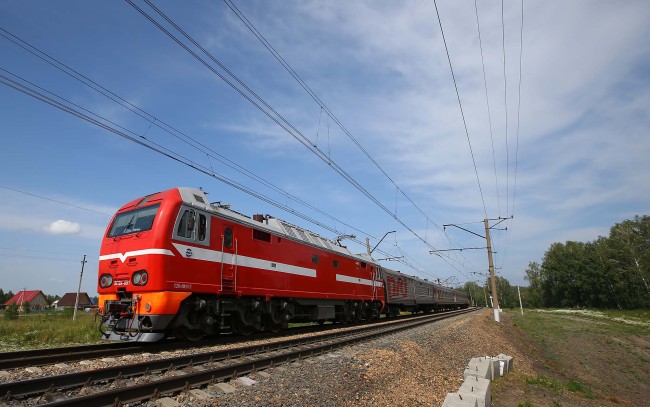As Seoul’s concrete jungle fades into the background, the train slowly slides into an unusual landscape that blends pristine, lush forests and strips of barbed-wire fences in the lead up to an iron bridge over the Imjingang River.
The DMZ Peace Train ends at Dorasan, South Korea’s northernmost rail station just 17 kilometers from the North Korean city of Gaeseong. Aboard were some 150 passengers who recently completed a 20-day, 14,400-kilometer journey on the “Eurasia Express” linking Asia and Europe. The journey last month started from Vladivostok and Beijing and ended in Berlin, Germany, capped off with celebratory events longing for peace and prosperity throughout the Eurasia continent.
 |
The Eurasia Express runs on the track near Novosibirsk, Russia, July 22. Yonhap |
Designed primarily to celebrate the feat, the special 80-minute DMZ trip Monday epitomized the blankness that kept reoccurring throughout the Eurasia itinerary in which North Korea remained absent, increasing the awareness of the need for unification of the two Koreas. With Pyongyang abstaining, the participants had to fly to Russia and China to board trains there.
“Being not of the Korean War generation and with no family members living in the North, I had never really felt in earnest why we had to be reunited, but the Eurasia Express offered me a chance to change my understanding about North Korea and the unification,” Lee Soo-hyun, a makeup artist who took part in the project, said at the ceremony at Dorasan Station in Paju, Gyeonggi Province.
The train program came as South Korea sets its sights on the Eurasian continent as it seeks to broaden its diplomatic and economic horizons and facilitate its future unification with the North through international collaboration.
It was a centerpiece of President Park Geun-hye’s “Eurasia Initiative,” a package of projects, such as to connect railways, roads and ports to Europe via North Korea, China, Russia and Central Asia, as well as an integrated Eurasia power grid and a logistics hub.
For Seoul, the continent is a treasure trove of opportunities for energy supplies, economic growth and cultural exchange.
The Park administration sees the ambitious scheme as being able to cater to not only its own proposed vision to boost peace and trust in Northeast Asia, but also Beijing’s so-called One Belt One Road plan that envisions “land and maritime silk roads” all the way to Europe and even Africa, and Moscow’s drive to reinforce relations with Asia Pacific nations chiefly to revamp the underdeveloped Far East.
Yet the initiative will have to tackle daunting hurdles in order to take off. With protracted cross-border gridlock, North Korea remains aloof toward the rail and other industrial partnerships, while tension persists across the continent amid Russia’s standoff with the West over the Ukraine crisis.
The outlook for what Seoul envisions as “one Eurasia” is darkening further in the wake of Pyongyang’s land mine attack and artillery exchanges that have pushed up cross-border tension to a new high.
On a weekday afternoon, Dorasan Station appeared hollower than ever, highlighting the irony of a large welcome sign reading, “Not the last station from the South, but the first station toward the North.”
By Shin Hyon-hee (
heeshin@heraldcorp.com)








